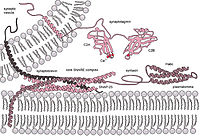
Photo from wikipedia
Botulinum neurotoxins (BoNTs) are the most potent toxins known in nature produced by Clostridium botulinum strains, which can cause life-threatening diseases in both humans and animals. The latter is of… Click to show full abstract
Botulinum neurotoxins (BoNTs) are the most potent toxins known in nature produced by Clostridium botulinum strains, which can cause life-threatening diseases in both humans and animals. The latter is of serious environmental and economic concern, resulting in high mortality, production losses, and rejection of contaminated animal feed. The available in vivo mouse assay is inadequate for real-time and on-site assessment of outbreaks. Herein, we present a reflective-based approach for the detection of BoNT/C while estimating its activity. Two adjacent porous Si Fabry-Pérot interferometers are simultaneously utilized to quantify minute BoNT/C concentrations by a competitive immunoassay and to assess their endopeptidase activity. The reflectivity signals of each interferometer are amplified by biochemical reaction products infiltration into the scaffold or by peptide fragments detachment from the nanostructure. The optical assay is highly sensitive in compliance with the in vivo approach by presenting a detection limit of 4.24 pg mL-1. The specificity and selectivity of the designed platform are cross-validated against BoNT/B and BoNT/D, also relevant to animal health. Finally, the analytical performances of both interferometers for real-life scenarios are confirmed using actual toxins while depicting excellent compliance to complex media analysis. Overall, the presented sensing scheme offers an efficient, rapid, and label-free approach for potential biodiagnostic elucidation of botulism outbreaks.
Journal Title: Analytical chemistry
Year Published: 2022
Link to full text (if available)
Share on Social Media: Sign Up to like & get
recommendations!